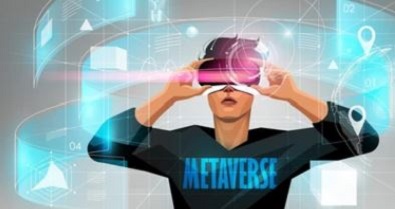REGULATING METAVERSE MEDIA
Introduction
The Metaverse has emerged very fast as a digital environment in which individuals socialize and transact their business in ways that have also brought up crucial concerns on rights, protection, and regulations. The traditional IP laws were created to apply to physical goods, and the emergence of virtual assets, AI-generated content, and NFTs threatens the effectiveness of such laws. With the blurring of the lines between creators, users, and platforms caused by virtual concerts, fashion shows, and NFT galleries, the problem of ownership, digital likeness, and accountability becomes more complicated[1].
Regulatory frameworks need to change in this borderless environment to protect the rights of creators and to facilitate the development of innovation. It is all about making a difference between the new virtual ecosystems and the current media and IP regulations[2].
The emergence of the metaverse has set out a new intellectual property (IP) law barricade. With virtual environments now being highly interactive, a socializing environment, an economic environment, and a creative expressive environment, the demand has placed a lot of importance on an effective and versatile IP protection. Copyrights, trademarks and patents, which used to be created to support physical property, need to support digital property, virtual experiences and user-generated content that run on fluid, decentralized platforms.
Copyright in the Metaverse
Copyright law continues to be the main force of defending original online works including virtual art, avatars, music and immersible designs[3]. The simplicity with which this digital property can be copied, refined and edited in the metaverse makes the issue of ownership and authorship problematic. One copyrighted work can rapidly turn out to become several user-modified versions of the original, making it difficult to determine who is a derivative and who is original[4]. Such changes question the idea of the sole copyright and make the courts and legislatures rethink what can be a new work and how the rights of the original creators and the users are to be used in harmony.[5]
Trademarks and Protections of Brands.
With the increasing number of companies venturing in the virtual worlds, the trademark law has gained critical role in ensuring brand identity protection. Companies are developing online storefronts, branded digital fashion and online experiences in brands. These elements, including logos, names, and other distinctive features, are protected by trademarks against their unauthorized usage that will lead to confusion of the consumers or watering down of a brand. Copies of digital products, counterfeit online stores and faked brand experiences can damage the businesses and consumers. Trademark of virtual goods guarantees brand security, avoids deceit and gives companies the green light to enter digital markets without fear.
Emerging Technologies and patents.
Patents have been at the centre of technological innovation protection that drives the metaverse, the virtual reality (VR) hardware, the augmented reality (AR) tools, haptic devices, and the newer forms of digital interaction. Patents promote investment and innovation as it offers the inventor the rights to exclusive control of the invention. Meanwhile, the many metaverse technologies are digital, which simplifies copying or reverse-engineering and increases the difficulty in enforcing. Blockchain and non-fungible tokens (NFTs) are the technologies that can provide a solution by assisting in verifying authenticity and tracing ownership, yet they also pose new legal challenges.[6]
Virtual Asset Ownership vs. Virtual Asset licensing.
The concept of owning and licensing digital assets is one of the most complicated processes in the metaverse. Users tend to assume that they have ownership of virtual objects like avatars wearables, online art or online land. As a matter of fact, the majority of platforms offer a narrowly scoped license that is regulated by the terms of service. These licenses allow one to access the asset without the ownership rights of reselling, altering, and unrestricted transfer of the asset[7]. Platforms pose high control, that is, user rights can be altered in case the platform changes its policies or closes down.
Such platforms as Roblox and Decentraland provide more space to creators to design and sell digital goods, but they also include content policies, moderation policies, and profit-sharing frameworks. Such a compromise in autonomy of creators and control of platforms generates a successful digital economy and creates anxiety over future security of ownership. When a platform changes its conditions, blocks access or stops working, users will immediately lose their investments. These dangers show the immediate necessity of creating a better understanding of legal regulations on the rights of virtual assets, their transferability, or accountability of the platform.[8]
NFTs and blockchain provide additional methods of proving ownership and tracking of provenance of virtual assets. Nonetheless, they also pose a regulatory issue since the legal definition of the ownership of a token and the ownership of the underlying digital asset is not fully resolved. In the absence of articulated rules, users, creators and investors will continue to be susceptible to conflicts and jurisdiction differences.
Implementation of IP Rights
The metaverse is globally and decentrally distributed, making it challenging to enforce IP in the metaverse. Consumers communicate internationally, and it is challenging to establish jurisdiction. Digital property is easy to clone, share and alter, and in most cases it is not traceable. This would render it difficult to prevent infringement or act against unauthorized exploitations by creators and right owners[9].
Forgery of virtual objects and copyrighted personal art, and trademark infringements can propagate quickly through the platforms. It is impossible to police all these cases of infringement, particularly when assets are traversed through decentralized networks and user generated spaces.
NFTs and blockchain are the potential technologies to serve such purposes. Assigning discrete identifiers to digital objects and recording ownership records by the decentralized ledgers, NFTs can verify digital objects and trace their movement across systems. Ownership of an NFT, however, does not imply the rights to own copyright and related IP rights. This false belief has contributed to a large degree of confusion and this is where legal definitions are necessary.
There is also a difference in the legal systems in dealing with digital ownership and tokenized assets. Consequently, creators and companies will not be able to enforce their rights across borders, particularly when various countries make dissimilar regulations on NFTs and digital assets.
To cover these difficulties, legislators and legal professionals suggest several changes, among which are:
- more precise definitions of ownership of the digital.
- user rights in virtual worlds.
- digital-asset system interoperability.
- new copywrite, trademark, and patent laws, which are specific to online spaces.
These reforms would safeguard creators, foster consumer confidence and have a fair and innovative digital economy.
Case Studies
Despite the fact that legal precedent in the metaverse is still growing, a number of large cases and corporate projects are dictating the future of IP protection.
Nike[10] and Gucci are the companies that already intend to protect the trademarks of the digital products, which is why they have already submitted their applications to cover virtual clothes, footwear, and accessories. These measures are guarding against web counterfeits of their brands and this gesture is a clear indication to businesses how much they treasure their existence in cyber worlds.
One landmark case is Hermes v. Rothschild[11], engaging artist Mason Rothschild with MetaBirkins -NFTs of modified images of Hermes Birkin bags. The decision of the court was to support Hermes because traditional trademark law is applicable to NFTs and virtual products. The case established a big precedent as it stated that even digital copies of luxury products might violate trademarks, as the counterfeits do.
Such advances demonstrate how old IP principles are being stretched and used to cover digital property. Nike as an example has not just obtained digital trademarks, but has been buying digital asset companies to enhance its virtual product line. Such activities reveal how companies consider IP protection in the metaverse to be important to preserve exclusivity and consumer confidence.
Courts will be of vital importance as more conflicts arise and determine the boundaries of the digital ownership, the legality of derivatives and the liability of creators and platforms. Laws might require adjusting to legal provisions on matters of changing, reselling, inter-operability and controlling the platform of virtual products.
Conclusion
The metaverse is changing the nature of intellectual property law due to its rapid transformation. The further mindful to operate in the digital realms, businesses, creators, and consumers need to safeguard IP rights to enhance innovation, equity, and economic development. The peculiarity of virtual resources puts in question the traditional concept of property, copyright, and originality and compels legal institutions and legislatures to reconsider established values.
Criminal cases with high profile such as Hermes v. Cases of Rothschild and corporate incentives of Nike and Gucci indicate the necessity to change the legal frameworks in an urgent manner. Emerging technologies like blockchain and NFTs are promising tools, but they also present some questions that current laws are not sufficiently prepared to provide the answers to.
In the future, policymakers, law professionals, and industry players should come up with flexible, transparent, and all-encompassing IP rules that are appropriate in the metaverse. These structures will contribute to safeguarding the rights of the creators, consumer confidence, and a successful digital economy. With the optimal approach of innovation without violating the IP, the metaverse will evolve into a safe and vibrant space where companies and creators can grow and engage with each other with relative confidence.
Author:–Sonakshi Desai, in case of any queries please contact/write back to us at support@ipandlegalfilings.com or IP & Legal Filing.
References
- Primavera De Filippi & Aaron Wright, Blockchain and the Law (2018)
- Aaron Perzanowski & Jason Schultz, The End of Ownership (2016)
- Mark A. Lemley & Eugene Volokh, Law, Virtual Reality, and Augmented Reality, 166 U. Pa. L. Rev. 1051 (2018)
- WIPO Magazine, https://www.wipo.int/en/web/wipo-magazine/articles/the-metaverse-nfts-and-ip-rights-to-regulate-or-not-to-regulate-42603
- Content, Intellectual Property and the Metaverse; https://www.mondaq.com/india/copyright/1214846/content-intellectual-property-the-metaverse
- The (virtual) battle for intellectual property rights in the metaverse: The case of copyright, trademarks and the NFT technology, Rocco Limongelli, Ludovica Sposini, Article ID: 3056, Vol 6, Issue 1, 2025.
[1] Mark A. Lemley & Eugene Volokh, Law, Virtual Reality, and Augmented Reality, 166 U. Pa. L. Rev. 1051, 1055–58 (2018)
[2] World Intellectual Property Organization, WIPO Conversation on IP and the Metaverse (2022), https://www.wipo.int/.
[3] 17 U.S.C. §§ 101–122
[4] Lemley & Volokh, supra note 1
[5] Id.
[6] Sarah Thompson, “Blockchain and NFTs: New Frontiers in IP Protection,” 14 Digital Asset L.J. 89, 92 (2023).
[7] Julie A. Cohen, “Owning the Virtual World: Property and Possession in the Metaverse,” 23 Harv. J.L. & Tech. 333, 336 (2021).
[8] John B. Thomson, “Governance in Virtual Platforms,” 10 J. Online Bus. L. 89, 92 (2023).
[9] William M. Landes & Richard A. Posner, “The Economics of Intellectual Property Law,” 22 Geo. L.J. 94, 96 (2023).
[10] Robert P. Merges, “Nike’s Virtual Goods Strategy and Brand Protection,” 32 Harv. J.L. & Tech. 92, 94 (2023).
[11] Hermès Int’l v. Rothschild, No. 1:22-cv-00384 (S.D.N.Y. 2022)



